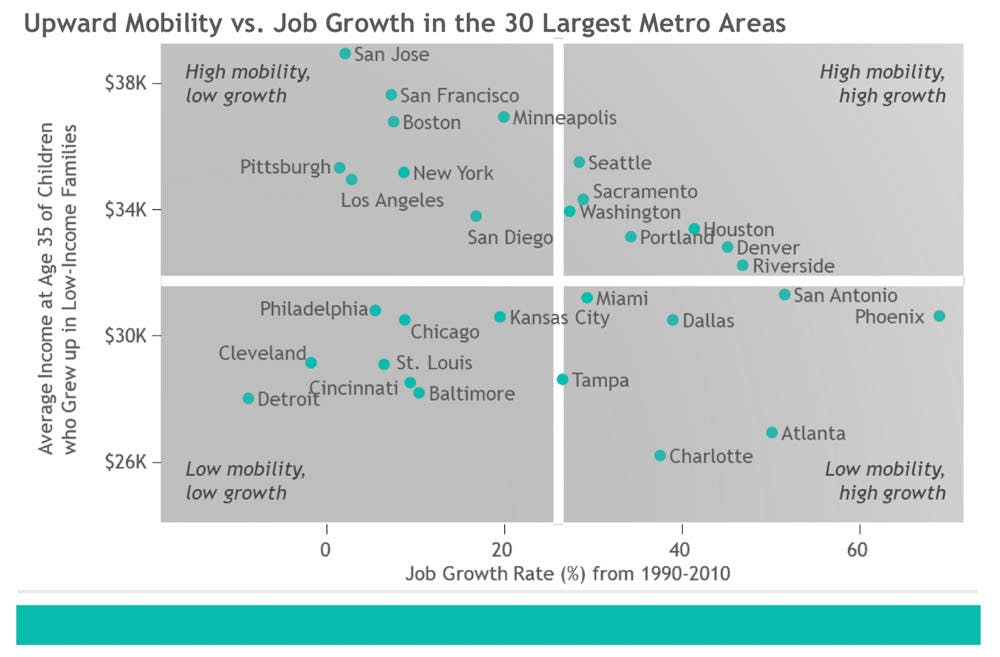It is well known that a person’s environment impacts them in many ways, but researchers have recently found that upward mobility is influenced not only by the city or region where a person grew up, but the exact neighborhood they called home. A team led in part by Professor of Economics John Friedman, as well as researchers from Harvard and the U.S. Census Bureau, published the “Opportunity Atlas” last Monday, and with it launched “Opportunity Insights,” a research and policy organization based at Harvard.
The “Opportunity Atlas” creates new, highly localized metrics for measuring neighborhood quality and has been in the works for roughly 18 months, Friedman said. The interactive infographic and accompanying research paper build on foundational research that “looked at intergenerational mobility and kid’s long-term outcomes” across certain cities and colleges. The Opportunity Atlas used similar methods to study variations in upward mobility between neighborhoods, with a particular focus on the economic prospects of low-income children.
This effort began as an “informal research consortium” called the Equality of Opportunity Project, said Shannon Felton Spence MPA ’17, communications director of Opportunity Insights. This consortium had privileged access to large administrative data sets gathered as part of the Census in 2000 and 2010 and federal income tax data gathered by the Internal Revenue Service. “There was always an appetite from local policymakers across the country to use that data in their own daily policy making,” Felton Spence said, adding that policymakers reached out to the economists in the consortium, such as Friedman, for guidance on how this data could be applied. This call for collaboration inspired the creation of Opportunity Insights, which aims to make data accessible for policymakers and public officials.
The Opportunity Atlas analyzed the data of 20 million Americans in their mid-thirties and mapped this data onto their hometowns in order to assess each neighborhood. The study estimates “children’s average earnings” within a neighborhood; these estimates vary depending on parental income, gender and race, according to the “Opportunity Atlas” executive summary.
“From a policymaking perspective, if we wanted to understand things that were happening across broad swaths of childhood — we really needed to get inside the city,” Friedman said. As a result, Freidman and his fellow researchers adopted a highly localized approach, focusing on specific neighborhoods rather than the cities as wholes. Given the degrees to which different areas within a large city vary, “thinking about it as a whole, especially for the outcomes of kids, just didn’t seem right,” Friedman added.
In order to take a more detailed look at districts in the United States, the group analyzed “census tracts,” which are subdivisions devised for census data collection. The study showed that the poverty level within each tract impacted outcomes for children who grew up there, Friedman said.
Researchers also examined whether or not adjacent tracts, or nearby neighborhoods, have an impact on outcomes. The study concluded that economic mobility outcomes “only correlate within your census tract … even blocks in your census tract that are further away than about half a mile don’t really correlate with your outcomes. It’s this incredibly localized impact of neighborhood that seems to matter the most,” Friedman said.
Another important facet of Friedman and his team’s work was its capacity to show how “neighborhoods may really matter in different ways for different groups. Even within an area, African American versus Hispanic individuals (for example) … seem to have different outcomes,” said Eric Chyn, assistant professor of economics at the University of Virginia.
Policy interventions will have to consider these nuances resulting from race and gender in order to be successful, according to the executive summary.
“Just how much variation there is within cities is super important and that’s something that this study is directly trying to shed light on,” Chyn said.
The “Opportunity Atlas” interactive tool, available online, allows users to input their census tract and engage with the data for their region against the backdrop of national trends in social mobility.
Researchers and the general public are increasingly interested in “trying to understand neighborhood quality,” Friedman said. Neighborhoods have traditionally been assessed using statistics like home values, incomes, percent of residents with high school and college diplomas and job availability, for example. But these metrics fail to directly measure how children from a neighborhood fare later in life, Friedman said, adding that there may or may not be a correlation with children’s long-term outcomes.
Some of the common metrics that cities may use to describe growth or development actually don’t directly impact the outcomes of children growing up there, Friedman said. He drew upon the example of Atlanta, Georgia, where job growth is occurring at a rapid rate without any major positive impact on local residents since jobs are being filled by people from outside the city.
Only about half of the discrepancies in neighborhood quality can be predicted by these common metrics; sometimes two neighborhoods may look statistically similar but still differ in terms of the outcomes of children growing up there, Friedman said. The new metrics developed by “Opportunity Atlas” aim to provide a more accurate picture, he added.
Already, Opportunity Insights has influenced policy initiatives in various cities. “We are partnering with the Seattle Housing Authority and the King County Housing Authority in Washington to help families with housing vouchers understand what are neighborhoods that are higher opportunity and what are neighborhoods that are lower opportunity,” he said. “We are actively trying to help move kids to places that are better.”





